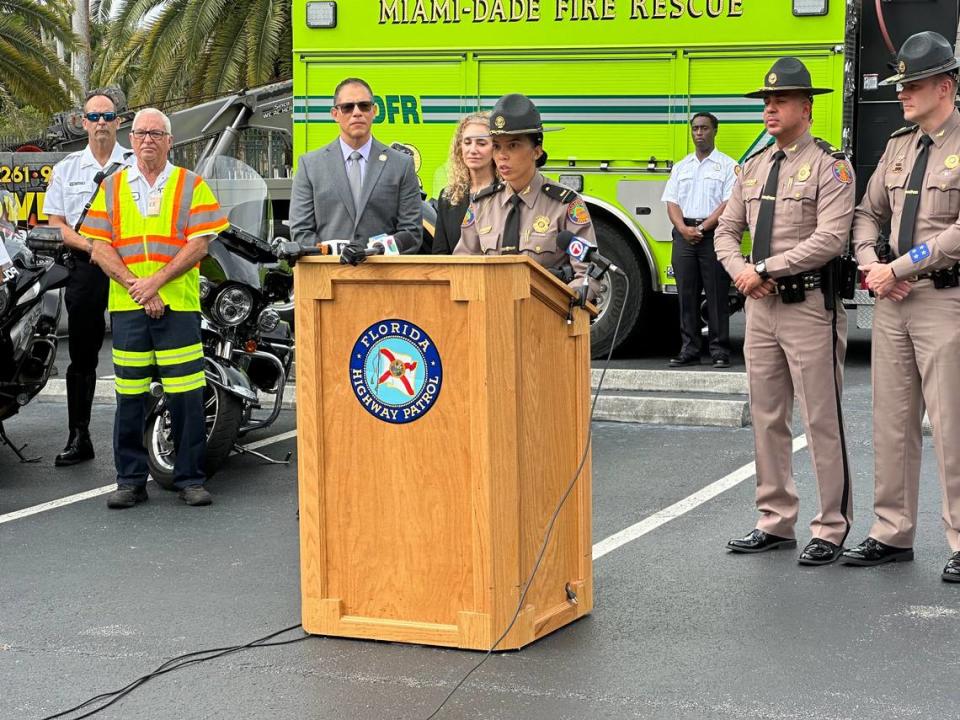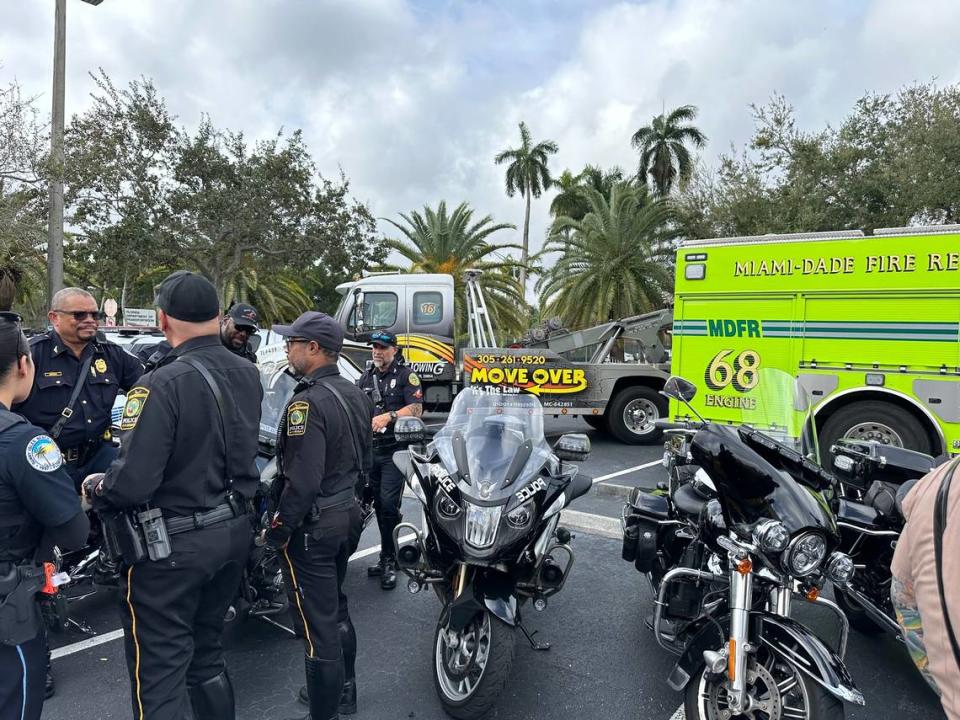You’re warned, Florida cops say. Now you can be fined for speeding next to disabled cars
Are you moving over?
More than a dozen members of the Florida Highway Patrol, Florida Department of Transportation, Miami-Dade Fire Rescue, Road Rangers and other first responders gathered outside FHP’s Miami Troop E headquarters in West Miami-Dade to spread awareness of a new addition to an old Florida traffic law.
“The easiest thing to remember is that if you see a vehicle stopped on the side of the road — regardless of what it is — just move over. It’s a common courtesy and it’s now the law,” Florida Highway Patrol Lt. Alex Camacho told the Miami Herald after a news conference Wednesday at FHP headquarters near Florida’s Turnpike.
January is “Move Over” Awareness Month in Florida. Officers around the state gathered Wednesday at similar public meetings to discuss the new amendment to a 2002 traffic law that requires drivers to shift over one lane — or reduce speed if moving into another lane isn’t safe — for “any stopped law enforcement, emergency, sanitation, and utility service vehicles, tow trucks or wreckers, and maintenance or construction vehicles with displayed warning lights.”
READ MORE: ‘Move over’ law is changing soon for drivers in Florida. What to know about new rules
KNOW MORE: New Florida laws for drivers, breastfeeding moms, campers, shoppers are now in effect
The law Camacho spoke of now requires drivers to move over a lane or at least slow down to a pace at least 20 miles under the posted speed limit when they see any stopped vehicle on the side of the road. Previously, the law only covered emergency and other official vehicles.
The everyday disabled vehicle could belong to a driver with a flat tire or an overheated engine who had to pull over on the side of the highway. Or maybe a driver is on the shoulder from feeling sick or attending to a crying baby in the back seat.
Whatever the reason, under the expanded law, the other drivers on the road need to pay attention and change their course under the expanded Move Over law.
Officers have discretion to warn or ticket drivers. New highway signs may be coming soon to help spread the word.
“There is no statutory grace period for the law’s change,” said FHP Lt. Jim Beauford, chief of public affairs, in an email to the Miami Herald from the Tallahassee office.
That point was addressed by FHP Lt. Indiana Miranda at the news briefing. “We will cite that motorist or educate him on the new law.”
Florida Department of Transportation road signs, such as the electronic ones overhead that announce upcoming hazards, should soon appear to reflect the amended law covering all disabled vehicles, not just emergency ones, Camacho and Miranda said.

But the law is enforceable — signs or not. The Move Over law is baked into the Florida Driver’s Handbook and the amended addition is official.
“I’ve been a trooper for 16 years and being on the side of the road is a scary place to be,” Camacho said. “Not everybody gets to experience that. And I can tell you with the Move Over law in place, it gives people that might find themselves in an emergency situation one less thing to worry about. When they have all these cars zoom in by them now they’ll have a little bit more space so they can resolve their issue whether it’s a flat tire, medical emergency, or whatever the case might be.”
There were more than 1,700 crashes, 128 of them serious, and eight deaths since 2015 because drivers did not follow the original Move Over law, Stacy Miller, Florida Department of Transportation-District 6 secretary, said outside FHP headquarters.
“Unfortunately, over the years, we have seen many troopers, firefighters, tow truck drivers, Road Rangers and construction workers injured or killed by someone not giving them room to work. This is 100% preventable,” added FHP Maj. Ellery Collado.
According to the Florida Highway Safety and Motor Vehicles, there were 170 crashes and more than 14,000 citations issued for drivers failing to move over in the state in 2022. Figures for 2023 should be available in February, said Beauford.
Statistically, the most likely to violate the law are drivers in the 20 to 40 age group.
“This demographic is less likely to move over or slow down when they approach emergency, service or disabled vehicles,” the department said in information released by Beauford.
What you need to know about the Move Over law
By state law that went into effect on Jan. 1, 2024, you must move over a lane or slow down in the following situations:
▪ There’s a stopped law enforcement, emergency, sanitation, utility service vehicle, tow truck or wrecker, maintenance or construction vehicle, with displayed warning lights. That’s in keeping with the original Move Over law. The amended 2024 law insists you do the same for:
▪ Disabled motor vehicles that are stopped and displaying warning lights or hazard lights.
▪ A vehicle that is stopped and using emergency flares or posting emergency signs.
▪ A vehicle that is stopped and one or more persons are visibly present.
There doesn’t have to be emergency signs or flares indicating the car is stuck on the side of the road. If you see someone inside or outside the car, move over or drop your speed.

How to comply
Here’s how to stay on the right side of the law.
▪ Move out of the lane closest to the disabled vehicle when driving on highways or streets with two or more lanes traveling in the direction of the stopped vehicle.
▪ If drivers can’t safely make that move, they must slow to 20 mph less than the posted speed limit when the posted limit is 25 mph or greater. Or travel at 5 mph when the posted speed limit is 20 mph or less.
Is there a fine for violating the Move Over law?
A violation of the Move Over law is a noncriminal traffic infraction, punishable as a moving violation, according to the state. The statutory base fine is $60 but with additional fees and surcharges, the total penalty may be up to $158. You can get points on your license, too, which may raise the cost of, or lead to the cancellation of, your car insurance. You could also get off with a warning. But why risk the hassle, let alone risk killing someone?
“Give them that common courtesy of slowing down for them,” Miranda said, “or moving over to the next lane.”


